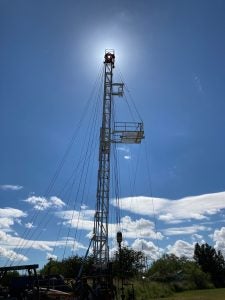 In the fall of 2021, after much effort by EDF and other stakeholders, Congress included $4.7 billion in funding as part of the bipartisan Infrastructure Investment and Jobs Act, to close as many “orphan” wells as possible, with a focus on leaky wells near communities.
In the fall of 2021, after much effort by EDF and other stakeholders, Congress included $4.7 billion in funding as part of the bipartisan Infrastructure Investment and Jobs Act, to close as many “orphan” wells as possible, with a focus on leaky wells near communities.
Last week, the first of these wells was plugged in a small town in Texas. Plugging this well marks a critical milestone for the program even as more work remains to be done to prevent more wells from becoming orphaned pollution risks.
When oil and gas wells are no longer productive, they must be “plugged” with cement to prevent leakage of methane, air toxics and salty, chemical-laden water into the environment. Unfortunately, all too often, operators fail to plug their wells in a timely fashion and go bankrupt or otherwise disappear, leaving states responsible for well closure. Because states have historically been underfunded for this work, there are over 120,000 documented “orphan” oil and gas wells across the country from New York to California, and potentially another 800,000 that have not yet been fully identified.
First “orphan” well plugged as federal program gains momentum, more to be done. Share on XFirst orphan well plugged, thousands more to follow
After a year of collaborative planning between the states and the Department of Interior, which oversees this funding, the first well closed under this funding was plugged in the small town of Refugio, Texas, near Corpus Christi (Illinois has also begun well closures with IIJA funding this month). This well, right in the middle of town, is located close to many homes — and nationwide nearly 10 million Americans live within a mile of a documented orphan well like this one, with many right next door to these pieces of polluting infrastructure.
Many thousands of high priority wells like these will be plugged over the next year as the program ramps up, with 50,000 or more such wells expected to be plugged under this funding through the end of the decade. Lots of these wells were drilled and abandoned many decades or even a century ago, and this infusion of funding is a once-in-a-lifetime opportunity to tackle the long-standing problem.
Preventing tomorrow’s orphans
While we begin to get a handle on the existing orphan well issue in the U.S., we must turn our attention to ensuring that today’s currently active fleet of nearly one million wells do not become tomorrow’s orphans.
The U.S. has hundreds of thousands of marginal (or “low-producing”) and idle wells, for which states and the Bureau of Land Management hold only pennies on the dollar in financial assurance to pay for plugging in case of operator bankruptcy. That means hundreds of thousands of wells at risk of becoming orphaned pollution liabilities unless action is taken.
States recognize the gravity of this problem and have begun reforms to ensure that all oil and gas wells are plugged in a timely fashion, at the end of their useful lives, with industry money — rather than at taxpayer expense.
In Alaska, reforms adopted in 2019 have increased the state’s bond holdings from $4 million to $90 million. In Colorado, reforms adopted in March of 2022 set the stage for eliminating orphan wells going forward — inspired in part by rules adopted by Arkansas in 2018 to require full-cost financial assurance for all marginal gas well upon transfer. Utah is also in the midst of a financial assurance rulemaking that will address operator liquidity and set limitations on multi-well bonds.
Between the work funded by the Infrastructure Investment and Jobs Act to plug existing orphan wells and efforts by the states to prevent new orphan wells going forward, the U.S. has a real opportunity to solve this persistent environmental and public health problem once and for all.









